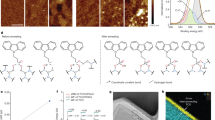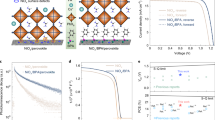Abstract
The efficiencies of all-perovskite tandem devices are improving quickly. However, their complex interconnection layer (ICL) structures—with typically four or more layers deposited by different processes—limit their prospects for applications. Here, we report an ICL in all-perovskite tandem cells consisting merely of a fullerene layer and a SnO2–x (0 < x < 1) layer. The C60 layer is unintentionally n-doped by iodine ions from the perovskite and thus acts as an effective electron collecting layer. The SnO2–x layer, formed by the incomplete oxidization of tin (x = 1.76), has ambipolar carrier transport property enabled by the presence of a large density of Sn2+. The C60/SnO1.76 ICL forms Ohmic contacts with both wide and narrow bandgap perovskite subcells with low contact resistivity. The ICL boosts the efficiencies of small-area tandem cells (5.9 mm2) and large-area tandem cells (1.15 cm2) to 24.4% and 22.2%, respectively. The tandem cells remain 94% of its initial efficiency after continues 1-sun illumination for 1,000 h.
This is a preview of subscription content, access via your institution
Access options
Access Nature and 54 other Nature Portfolio journals
Get Nature+, our best-value online-access subscription
$29.99 / 30 days
cancel any time
Subscribe to this journal
Receive 12 digital issues and online access to articles
$119.00 per year
only $9.92 per issue
Buy this article
- Purchase on Springer Link
- Instant access to full article PDF
Prices may be subject to local taxes which are calculated during checkout




Similar content being viewed by others
Data availability
All data generated or analysed during this study are included in the published article and its Supplementary Information and Source Data files.
References
Bush, K. A. et al. 23.6%-efficient monolithic perovskite/silicon tandem solar cells with improved stability. Nat. Energy 2, 17009 (2017).
Han, Q. et al. High-performance perovskite/Cu(In,Ga)Se2 monolithic tandem solar cells. Science 361, 904–908 (2018).
Chen, C.-C. et al. Perovskite/polymer monolithic hybrid tandem solar cells utilizing a low-temperature, full solution process. Mater. Horiz. 2, 203–211 (2015).
Lee, J.-W. et al. Halide perovskites for tandem solar cells. J. Phys. Chem. Lett. 8, 1999–2011 (2017).
Eperon, G. E. et al. Perovskite-perovskite tandem photovoltaics with optimized band gaps. Science 354, 861–865 (2016).
Eperon, G. E. et al. Formamidinium lead trihalide: a broadly tunable perovskite for efficient planar heterojunction solar cells. Energy Environ. Sci. 7, 982–988 (2014).
Sadhanala, A. et al. Blue-green color tunable solution processable organolead chloride–bromide mixed halide perovskites for optoelectronic applications. Nano Lett. 15, 6095–6101 (2015).
Hao, F., Stoumpos, C. C., Chang, R. P. H. & Kanatzidis, M. G. Anomalous band gap behavior in mixed Sn and Pb perovskites enables broadening of absorption spectrum in solar cells. J. Am. Chem. Soc. 136, 8094–8099 (2014).
McMeekin, D. P. et al. A mixed-cation lead mixed-halide perovskite absorber for tandem solar cells. Science 351, 151–155 (2016).
Jeon, N. J. et al. Solvent engineering for high-performance inorganic–organic hybrid perovskite solar cells. Nat. Mater. 13, 897–903 (2014).
Zhao, D. et al. Efficient two-terminal all-perovskite tandem solar cells enabled by high-quality low-bandgap absorber layers. Nat. Energy 3, 1093–1100 (2018).
Palmstrom, A. F. et al. Enabling flexible all-perovskite tandem solar cells. Joule 3, 2193–2204 (2019).
Tong, J. et al. Carrier lifetimes of >1 μs in Sn-Pb perovskites enable efficient all-perovskite tandem solar cells. Science 364, 475–479 (2019).
Lin, R. et al. Monolithic all-perovskite tandem solar cells with 24.8% efficiency exploiting comproportionation to suppress Sn(II) oxidation in precursor ink. Nat. Energy 4, 864–873 (2019).
Prasanna, R. et al. Design of low bandgap tin–lead halide perovskite solar cells to achieve thermal, atmospheric and operational stability. Nat. Energy 4, 939–947 (2019).
Shao, Y., Xiao, Z., Bi, C., Yuan, Y. & Huang, J. Origin and elimination of photocurrent hysteresis by fullerene passivation in CH3NH3PbI3 planar heterojunction solar cells. Nat. Commun. 5, 5784 (2014).
Wojciechowski, K. et al. C60 as an efficient n-type compact layer in perovskite solar cells. J. Phys. Chem. Lett. 6, 2399–2405 (2015).
Xu, J. et al. Perovskite–fullerene hybrid materials suppress hysteresis in planar diodes. Nat. Commun. 6, 7081 (2015).
Yoon, H., Kang, S. M., Lee, J.-K. & Choi, M. Hysteresis-free low-temperature-processed planar perovskite solar cells with 19.1% efficiency. Energy Environ. Sci. 9, 2262–2266 (2016).
Baena, J. P. C. et al. Highly efficient planar perovskite solar cells through band alignment engineering. Energy Environ. Sci. 8, 2928–2934 (2015).
Hu, T. et al. Indium‐free perovskite solar cells enabled by impermeable tin‐oxide electron extraction layers. Adv. Mater. 29, 1606656 (2017).
Kílíç, C. & Zunger, A. Origins of coexistence of conductivity and transparency in SnO2. Phys. Rev. Lett. 88, 095501 (2002).
Zhu, Z. et al. Enhanced efficiency and stability of inverted perovskite solar cells using highly crystalline SnO2 nanocrystals as the robust electron‐transporting layer. Adv. Mater. 28, 6478–6484 (2016).
Rao, H.-S. et al. Improving the extraction of photogenerated electrons with SnO2 nanocolloids for efficient planar perovskite solar cells. Adv. Funct. Mater. 25, 7200–7207 (2015).
Yang, G. et al. Effective carrier-concentration tuning of SnO2 quantum dot electron-selective layers for high-performance planar perovskite solar cells. Adv. Mater. 30, 1706023 (2018).
Jarzebski, Z. M. & Marton, J. P. Physical properties of SnO2 materials: II. Electrical properties. J. Electrochem. Soc. 123, 299C–310C (1976).
Li, C. et al. Reducing saturation‐current density to realize high‐efficiency low‐bandgap mixed tin–lead halide perovskite solar cells. Adv. Energy Mater. 9, 1803135 (2019).
Zhao, D. et al. Low-bandgap mixed tin–lead iodide perovskite absorbers with long carrier lifetimes for all-perovskite tandem solar cells. Nat. Energy 2, 17018 (2017).
You, J. et al. A polymer tandem solar cell with 10.6% power conversion efficiency. Nat. Commun. 4, 1446 (2013).
Dou, L. et al. Tandem polymer solar cells featuring a spectrally matched low-bandgap polymer. Nat. Photonics 6, 180–185 (2012).
Chou, C.-H., Kwan, W. L., Hong, Z., Chen, L.-M. & Yang, Y. A metal‐oxide interconnection layer for polymer tandem solar cells with an inverted architecture. Adv. Mater. 23, 1282–1286 (2011).
Zhang, K. et al. High‐performance polymer tandem solar cells employing a new n‐type conjugated polymer as an interconnecting layer. Adv. Mater. 28, 4817–4823 (2016).
R. J Booth H. C Starkie M. C. R Symons R. S Eachus 1973 Unstable intermediates. Part CXXXV. The formation of Sn3+ and Pb3+ centres in irradiated tin and lead salts, and their electron spin resonance parameters J. Chem. Soc. Dalton Trans. 21 2233 2236.
Godinho, K. G., Walsh, A. & Watson, G. W. Energetic and electronic structure analysis of intrinsic defects in SnO2. J. Phys. Chem. C 113, 439–448 (2009).
Arularasu, M. V. et al. Structural, optical, morphological and microbial studies on SnO2 nanoparticles prepared by co-precipitation method. J. Nanosci. Nanotechnol. 18, 3511–3517 (2018).
Zhou, W., Liu, Y., Yang, Y. & Wu, P. Band gap engineering of SnO2 by epitaxial strain: experimental and theoretical investigations. J. Phys. Chem. C 118, 6448–6453 (2014).
Normura, K., Kamiya, T. & Hosono, H. Ambipolar oxide thin‐film transistor. Adv. Mater. 23, 3431–3434 (2011).
Togo, A., Oba, F., Tanaka, I. & Tatsumi, K. First-principles calculations of native defects in tin monoxide. Phys. Rev. B 74, 195128 (2006).
Wang, Z., Nayak, P. K., Caraveo-Frescas, J. A. & Alshareef, H. N. Recent developments in p-type oxide semiconductor materials and devices. Adv. Mater. 28, 3831–3892 (2016).
Varley, J. B., Schleife, A., Janotti, A. & Van de Walle, C. G. Ambipolar doping in SnO. Appl. Phys. Lett. 103, 082118 (2013).
Ha, V.-A., Ricci, F., Rignanese, G.-M. & Hautier, G. Structural design principles for low hole effective mass s-orbital-based p-type oxides. J. Mater. Chem. C 5, 5772–5779 (2017).
Ogo, Y. et al. Tin monoxide as an s-orbital-based p-type oxide semiconductor: electronic structures and TFT application. Phys. Status Solidi A 206, 2187–2191 (2009).
Zheng, X. et al. Defect passivation in hybrid perovskite solar cells using quaternary ammonium halide anions and cations. Nat. Energy 2, 17102 (2017).
Li, C.-Z. et al. Doping of fullerenes via anion-induced electron transfer and its implication for surfactant facilitated high performance polymer solar cells. Adv. Mater. 25, 4425–4430 (2013).
Sun, X. et al. Halide anion–fullerene π noncovalent interactions: n-doping and a halide anion migration mechanism in p–i–n perovskite solar cells. J. Mater. Chem. A 5, 20720–20728 (2017).
Bai, Y. et al. Enhancing stability and efficiency of perovskite solar cells with crosslinkable silane-functionalized and doped fullerene. Nat. Commun. 7, 12806 (2016).
Bush, K. A. et al. Compositional engineering for efficient wide band gap perovskites with improved stability to photoinduced phase segregation. ACS Energy Lett. 3, 428–435 (2018).
Chen, S. et al. Exploring the stability of novel wide bandgap perovskites by a robot based high throughput approach. Adv. Energy Mater. 8, 1701543 (2018).
Leijtens, T. et al. Tin–lead halide perovskites with improved thermal and air stability for efficient all-perovskite tandem solar cells. Sustain. Energy Fuels 2, 2450–2459 (2018).
Han, Q. et al. Low-temperature processed inorganic hole transport layer for efficient and stable mixed Pb-Sn low-bandgap perovskite solar cells. Sci. Bull. 64, 1399–1401 (2019).
Yang, Z. et al. Enhancing electron diffusion length in narrow-bandgap perovskites for efficient monolithic perovskite tandem solar cells. Nat. Commun. 10, 4498 (2019).
Wang, Q. et al. Qualifying composition dependent p and n self-doping in CH3NH3PbI3. Appl. Phys. Lett. 105, 163508 (2014).
Acknowledgements
This material is based on work supported by the Office of Energy Efficiency and Renewable Energy (EERE) of the US Department of Energy under Solar Energy Technologies Office (SETO) agreement numbers DE-EE0006709 and DE-EE0008749, and by the Research Opportunities Initiative of the University of North Carolina System.
Author information
Authors and Affiliations
Contributions
J.H. conceived the study. J.H. and Z. Yu designed the experiments. Z. Yu and Z. Yang fabricated the tandem devices and conducted the characterization. Z. Yang optimized the NBG perovskite solar cells. Z.N. studied the electronic structure and characterization of tin oxide. Z.N. and Y.S. performed the Hall effect measurement. B.C. measured the EQE spectra and took the SEM images. Y.L. and H.W. analysed the data. Z.J.Y. and Z.H. verified the J–V curves of the tandem device by using their dual-lamp solar simulator. J.H. and Z. Yu wrote the paper, and all authors reviewed the paper.
Corresponding author
Ethics declarations
Competing interests
The authors declare no competing interests.
Additional information
Publisher’s note Springer Nature remains neutral with regard to jurisdictional claims in published maps and institutional affiliations.
Supplementary information
Supplementary Information
Supplementary Figs. 1–20 and Supplementary Tables 1–7.
Rights and permissions
About this article
Cite this article
Yu, Z., Yang, Z., Ni, Z. et al. Simplified interconnection structure based on C60/SnO2-x for all-perovskite tandem solar cells. Nat Energy 5, 657–665 (2020). https://doi.org/10.1038/s41560-020-0657-y
Received:
Accepted:
Published:
Issue Date:
DOI: https://doi.org/10.1038/s41560-020-0657-y
This article is cited by
-
Enhancing the efficiency and longevity of inverted perovskite solar cells with antimony-doped tin oxides
Nature Energy (2024)
-
Perovskite–organic tandem solar cells
Nature Reviews Materials (2024)
-
Disentangling the multiorbital contributions of excitons by photoemission exciton tomography
Nature Communications (2024)
-
Electron-withdrawing organic ligand for high-efficiency all-perovskite tandem solar cells
Nature Energy (2024)
-
Strongly Coupled Ag/Sn–SnO2 Nanosheets Toward CO2 Electroreduction to Pure HCOOH Solutions at Ampere-Level Current
Nano-Micro Letters (2024)



